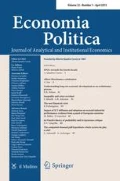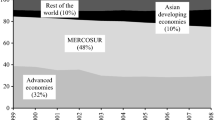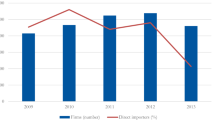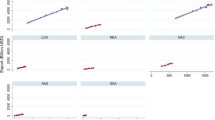Abstract
This paper looks at the question of how import activities and productivity are related. Using detailed production and cost data from a panel of Mexican manufacturing plants between 1994 and 2003, the paper is able to differentiate between two types of imports, materials (or intermediate inputs) and machinery and equipment (or capital goods), and to separately identify self-selection and learning effects of each type of imports at the plant level. The key findings are that there is evidence of both self-selection into importing and learning-by-importing, but not all imports seem to matter for productivity. Not only more productive plants tend to become importers of machinery and equipment rather than materials, but plants that start importing machinery and equipment also experience an increase in productivity, while the same does not occur when plants start importing materials. There is also evidence of productivity gains following entry into export markets and complementarities between exporting, importing materials and importing machinery and equipment. These findings seem to suggest that capital goods from abroad are more likely to embody technological improvements than intermediate inputs.



Similar content being viewed by others
Notes
The years covered by the original datasets go up to 2007, however information for imported capital goods is not available from 2004 onwards.
In the rest of the analysis, information at the product level is not used as the main interest is on plant-level variables, such as productivity and trade status. However, an ever increasing strand of the trade literature suggests that multi-product firms may differ along several dimensions from single-product firms (see, for example, De Loecker et al., 2016, and Caselli et al., 2017). Therefore, as a robustness check, the production function estimation and the econometric analysis in the next section are augmented by including a dummy variable equal to one if a plant produces more than one product in a given year as an additional proxy for productivity. The dummy for multi-product plants turns out not to be related to productivity in any significant way and the main findings are not affected by its inclusion. The additional results are available upon request.
The price of a product-plant-year triplet is measured by lumping together the product varieties sold to both the domestic and export markets, thus assuming that varieties do not vary by market. As a robustness check, this assumption is dropped and the price of a variety is differentiated by market as well. Results are not affected by this assumption and are available upon request.
The trade status of a plant may potentially affect not only its productivity, but also its technology. Therefore, as a robustness check, the production function in Eq. (1) is modified by including plants’ trade status via interactions with the factors of production. The main results regarding self-selection into importing machinery and equipment and learning effects due to exporting and importing of machinery and equipment are not affected qualitatively, but the significance of the coefficients is stronger and further evidence is found in favour of self-selection into exporting. Additional results are available upon request.
As a robustness check, the productivity process is assumed to be affected by export and import shares instead of dummies for plants’ trade status. This implies a modification of both the estimation of the production function and the productivity regressions in the next section. The main findings are not affected as the results show that more imports of machinery and equipment have a positive effect on productivity, while more imports of materials have a negative or no effect on productivity. Results are available upon request.
The specifications based on the WLP and WLP-FE estimators include lagged capital and its square, lagged materials and its square and the interaction of lagged capital and materials as additional proxies for productivity. Moreover, these specifications instrument current labour and materials with the first and second lags of labour as well as the second lags of capital and materials.
Plants that export, import materials or import machinery and equipment in 1994, the first year in the sample, are not included in the respective figures. The qualitative results do not change when plant-year observations that stop trading internationally are eliminated from the sample in each figure.
As the relationship between plants’ trade status and productivity is the main interest of this paper, the trade-related variables are included in all specifications, as was done for the estimation of the production function.
As a robustness check, the second-order polynomial in lagged capital and materials has also been included in all these regressions and the results do not change qualitatively. The basic results are shown for a simpler comparison with the rest of the literature, but the additional results are available upon request.
References
Ackerberg, D. A., Caves, K., & Frazer, G. (2015). Identification properties of recent production function estimators. Econometrica, 83, 2411–2451.
Agostino, M., Giunta, A., Scalera, D., & Trivieri, F. (2016). Imports productivity and global value chains: A European firm-level analysis. Mimeo. (unpublished)
Altomonte, C., Barattieri, A., & Rungi, A. (2014). Import penetration, intermediate inputs and productivity: Evidence from Italian firms. Rivista Italiana Degli Economisti, XIX(1), 45–66.
Amiti, M., & Konings, J. (2007). Trade liberalization, intermediate inputs, and productivity: Evidence from indonesia. American Economic Review, 97(5), 1611–1638.
Andrews, D., Criscuolo, C. and Gal, P. (2016). The global productivity slowdown, technology divergence and public policy: A firm level perspective, OECD, productivity working papers, no. 5.
Ashraf, Q., & Galor, O. (2013). The ’out of Africa hypothesis, human genetic diversity, and comparative economic development’. American Economic Review, 103(1), 1–46.
Bas, M., & Strauss-Kahn, V. (2014). Does importing more inputs raise exports? Firm-level evidence from France. Review of World Economics (Weltwirtschaftliches Archiv), 150(2), 241–275.
Caselli, M. (2014). Trade, skill-biased technical change and wages in Mexican manufacturing. Applied Economics, 46(3), 336–348.
Caselli, M., Chatterjee, A. and Woodland, A. (2017). Multi-product exporters, variable markups and exchange rate fluctuations. Canadian Journal of Economics. doi:10.1111/caje.12289.
Castellani, D. and Fassio, C. (2016). Import, export and multinationality. Evidence from Swedish firms, Henley Business School, Reading University, John H Dunning Centre for International Business Discussion Papers, no. 2016–08.
Castellani, D., Serti, F., & Tomasi, C. (2010). Firms in international trade: importers and exporters heterogeneity in Italian manufacturing industry. The World Economy, 33(3), 424–457.
Conti, G., Turco, A. L., & Maggioni, D. (2014). Rethinking the import-productivity nexus for Italian manufacturing. Empirica, 41(4), 589–617.
Csillag, M. and Koren, M. (2011). Machines and machinists: Capital-skill complementarity from an international trade perspective, Center for Firms in the Global Economy, CeFiG working papers, no. 13.
De Loecker, J. (2007). Do exports generate higher productivity? Evidence from Slovenia. Journal of International Economics, 73(1), 69–98.
De Loecker, J. (2013). Detecting learning by exporting. American Economic Journal: Microeconomics, 5(3), 1–21.
De Loecker, J., Goldberg, P. K., Khandelwal, A. K., & Pavcnik, N. (2016). Prices, markups and trade reform. Econometrica, 84(2), 445–510.
Diewert, E., Fox, K. J. and Ivancic, L. (2009). Scanner data, time aggregation and the construction of price indexes, UBC Department of Economics, UBC Departmental Archives, no. 2009–48.
Eaton, J., & Kortum, S. (2001). Trade in capital goods. European Economic Review, 45(7), 1195–1235.
Eslava, M., Haltiwanger, J., Kugler, A., & Kugler, M. (2004). The effects of structural reforms on productivity and profitability enhancing reallocation: Evidence from Colombia. Journal of Development Economics, 75(2), 333–371.
Goldberg, P. K., Khandelwal, A. K., Pavcnik, N., & Topalova, P. (2010). Imported intermediate inputs and domestic product growth: Evidence from India. The Quarterly Journal of Economics, 125(4), 1727–1767.
Halpern, L., Koren, M., & Szeidl, A. (2015). Imported inputs and productivity. American Economic Review, 105(12), 3660–3703.
Iacovone, L. (2008). Exploring Mexican firm-level data. Mimeo
Ivancic, L., Erwin Diewert, W., & Fox, K. J. (2011). Scanner data, time aggregation and the construction of price indexes. Journal of Econometrics, 161(1), 24–35.
Kasahara, H., & Lapham, B. (2013). Productivity and the decision to import and export: Theory and evidence. Journal of International Economics, 89(2), 297–316.
Kasahara, H., & Rodrigue, J. (2008). Does the use of imported intermediates increase productivity? Plant-level evidence. Journal of Development Economics, 87(1), 106–118.
Kugler, M., & Verhoogen, E. (2009). Plants and imported inputs: new facts and an interpretation. American Economic Review: Papers & Proceedings, 99(2), 501–507.
Levinsohn, J., & Petrin, A. (2003). Estimating production functions using inputs to control for unobservables. Review of Economic Studies, 70(2), 317–341.
Muendler, M.-A. (2004). Trade, technology, and productivity: A study of Brazilian manufacturers, 1986–1998, CESifo Group Munich, CESifo working paper series, no. 1148.
Olley, G. S., & Pakes, A. (1996). The dynamics of productivity in telecommunications equipment industry. Econometrica, 64(6), 1263–1297.
Paul, C. J. M., & Yasar, M. (2009). Outsourcing, productivity, and input composition at the plant level. Canadian Journal of Economics, 42(2), 422–439.
Petrin, A., & Levinsohn, J. (2012). Measuring aggregate productivity growth using plant-level data. RAND Journal of Economics, 43(4), 705–725.
Silva, A., Afonso, O., & Africano, A. P. (2012). Learning-by-exporting: What we know and what we would like to know. The International Trade Journal, 26(3), 255–288.
Smeets, V., & Warzynski, F. (2013). Estimating productivity with multi-product firms, pricing heterogeneity and the role of international trade. Journal of International Economics, 90(2), 237–244.
Topalova, P., & Khandelwal, A. (2011). Trade liberalization and firm productivity: The case of India. The Review of Economics and Statistics, 93(3), 995–1009.
Van Biesebroeck, J. (2008). The sensitivity of productivity estimates: Revisiting three important debates. Journal of Business & Economic Statistics, 26(3), 311–328.
Vogel, A., & Wagner, J. (2010). Higher productivity in importing German manufacturing firms: Self-selection, learning from importing, or both? Review of World Economics (Weltwirtschaftliches Archiv), 145(4), 641–665.
Wagner, J. (2012). International trade and firm performance: A survey of empirical studies since 2006. Review of World Economics (Weltwirtschaftliches Archiv), 148(2), 235–267.
Wooldridge, J. M. (2009). On estimating firm-level production functions using proxy variables to control for unobservables. Economics Letters, 104(3), 112–114.
Yasar, M. (2013). Imported capital input, absorptive capacity, and firm performance: Evidence from firm-level data. Economic Inquiry, 51(1), 88–100.
Yu, M., & Li, J. (2014). Imported intermediate inputs, firm productivity and product complexity. The Japanese Economic Review, 65(2), 178–192.
Acknowledgements
I thank Stefano Schiavo and two anonymous reviewers for their helpful comments. Special thanks go to Abigail Durán and Gerardo Leyva for granting access to INEGI data at the offices of INEGI in Aguascalientes and to all INEGI employees who provided assistance and answered all questions, in particular to Gabriel Romero, Otoniel Soto and Armando Arallanes. All errors are mine.
Author information
Authors and Affiliations
Corresponding author
Rights and permissions
About this article
Cite this article
Caselli, M. Do all imports matter for productivity? Intermediate inputs vs capital goods. Econ Polit 35, 285–311 (2018). https://doi.org/10.1007/s40888-017-0071-5
Received:
Accepted:
Published:
Issue Date:
DOI: https://doi.org/10.1007/s40888-017-0071-5




